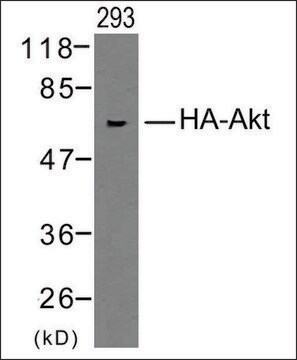04-902
Anti-HA Tag Antibody, clone DW2, rabbit monoclonal
culture supernatant, clone DW2, from rabbit
About This Item
Productos recomendados
biological source
rabbit
Quality Level
antibody form
culture supernatant
antibody product type
primary antibodies
clone
DW2, monoclonal
species reactivity
vertebrates (common species)
technique(s)
western blot: suitable
isotype
IgG
shipped in
dry ice
target post-translational modification
unmodified
General description
Specificity
Immunogen
Application
Epitope Tags & General Use
Epitope Tags
Quality
Lysates from non-transfected (lane 1) and HAtagged WNT-1 transfected (lane 2) HEK293 cells were resolved by electrophoresis, transferred to nitrocellulose and probed with anti-HA-Tag, clone DW2 (1:1,000 dilution).
Proteins were visualized using a goat anti-rabbit secondary antibody conjugated to HRP and a chemiluminescence detection system.
Arrow indicates the HA-tagged protein (~49 kDa). The apparent molecular weight is related to the tagged protein.
Target description
Linkage
Physical form
Storage and Stability
Analysis Note
HA-tagged WNT-1 protein.
Disclaimer
¿No encuentra el producto adecuado?
Pruebe nuestro Herramienta de selección de productos.
Storage Class
12 - Non Combustible Liquids
wgk_germany
WGK 1
flash_point_f
Not applicable
flash_point_c
Not applicable
Certificados de análisis (COA)
Busque Certificados de análisis (COA) introduciendo el número de lote del producto. Los números de lote se encuentran en la etiqueta del producto después de las palabras «Lot» o «Batch»
¿Ya tiene este producto?
Encuentre la documentación para los productos que ha comprado recientemente en la Biblioteca de documentos.
Nuestro equipo de científicos tiene experiencia en todas las áreas de investigación: Ciencias de la vida, Ciencia de los materiales, Síntesis química, Cromatografía, Analítica y muchas otras.
Póngase en contacto con el Servicio técnico